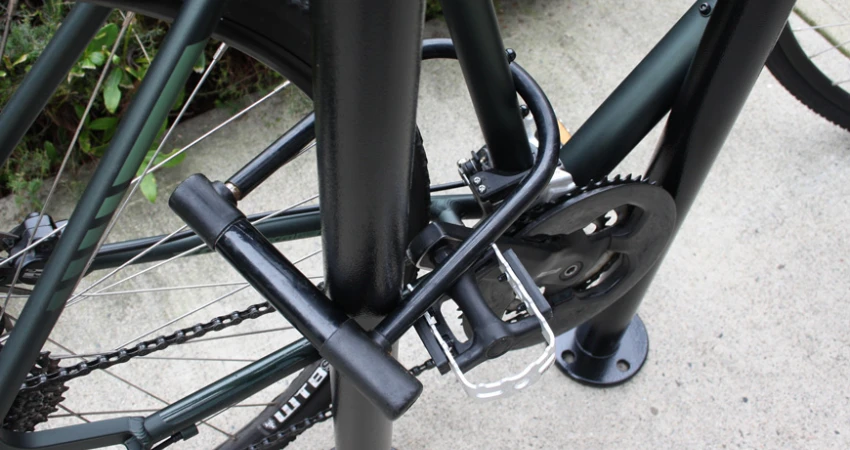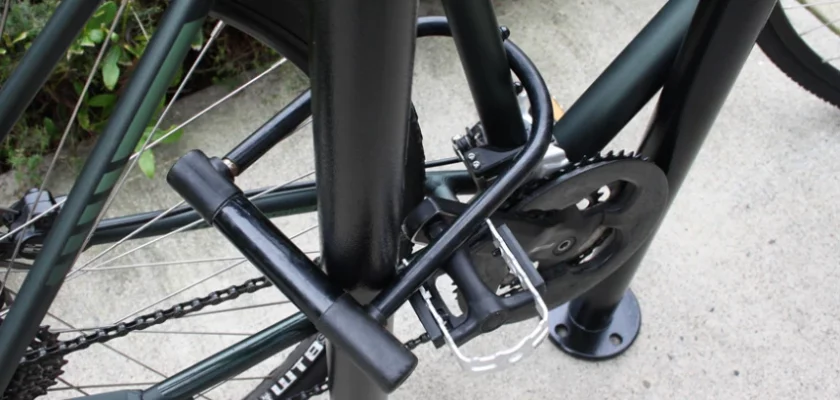Tired of worrying about your bike’s safety while it’s locked up outside? Look no further! In this article, we will dive into the ins and outs of securing your bike to a bike rack, ensuring peace of mind, and deterring potential thieves.
Whether you’re a seasoned cyclist or new to the biking scene, knowing how to properly secure your bike is essential.
So, how can you make sure your bike stays put on the bike rack? We’ve got you covered. From choosing the right lock to utilizing proper techniques, we will guide you through the steps to keep your bike safe and sound.
Get ready to learn the tricks of the trade that will make would-be thieves think twice before attempting to take your precious wheels. Stay tuned for our expert tips on how to secure your bike to a bike rack!
Securing Bike To Bike Rack: Essential Tips

Why Securing Your Bike to a Bike Rack is Important
Before we dive into the detailed steps of securing your bike to a bike rack, let’s discuss why it is crucial to do so. Bikes are valuable assets, and theft is a common concern for many cyclists.
By properly securing your bike to a bike rack, you can significantly reduce the risk of theft and ensure that your bike remains safe and in place while you attend to your other tasks.
Properly securing your bike to a bike rack also prevents accidental damage by preventing it from falling or rubbing against other bikes. With these reasons in mind, let’s explore the different methods and techniques for securing bike rack attachments.
Types of Bike Racks
To begin, let’s familiarize ourselves with the different types of bike racks available in the market. Understanding the various options will help you choose the right one for your specific needs and determine the appropriate way to secure your bike.
1. Hitch-Mounted Bike Racks
These racks are attached to the vehicle’s hitch receiver, making them sturdy and reliable.
Hitch-mounted racks come in different styles, including hanging-style racks and platform-style racks.
Hanging-style racks suspend the bike by its frame, while platform-style racks support the bike by the wheels.
2. Roof-Mounted Bike Racks
Roof-mounted racks are attached to the vehicle’s roof rack or crossbars.
This type of rack allows easy access to the rear of the vehicle and does not obstruct the driver’s view.
Roof-mounted racks often require additional lifting of the bike, which may be challenging for some individuals.
3. Trunk-Mounted Bike Racks
Trunk-mounted racks secure the bikes using straps that attach to the trunk or hatchback of the vehicle.
These racks are generally more affordable and easier to install than other types.
However, trunk-mounted racks may obstruct the rear visibility and access to the trunk.
Steps to Secure a Bike to a Bike Rack
Now that we have looked at the different types of bike racks, let’s go through the step-by-step process of securing your bike to a bike rack. The exact method may vary slightly depending on the rack type, so we will provide general guidelines that apply to most scenarios.
Step 1: Choose an Appropriate Bike Rack
Choosing the right bike rack for your needs is essential. Consider factors such as the number of bikes you need to transport, the type of vehicle you own, and your budget. Ensure that the bike rack is compatible with your bike frame and has adequate security features.
Step 2: Position the Bike Rack Correctly
To ensure stability and safety during transportation, correctly position the bike rack on your vehicle. Follow the manufacturer’s instructions for installation and make sure the rack is secured tightly. Double-check that the rack does not obstruct any lights, license plates, or other essential components of your vehicle.
Step 3: Prepare the Bike for Attachment
Before attaching your bike to the bike rack, prepare it by performing the following steps:
Remove any loose accessories or items from the bike, such as water bottles, saddlebags, or bike computers.
If possible, lower the bike’s seat or handlebars to reduce the risk of damage during transportation.
Engage the bike’s lockout mechanisms, such as locking the suspension or securing the folding parts if applicable.
Step 4: Attach the Bike to the Bike Rack
The attachment method depends on the type of bike rack you are using. Follow these guidelines:
For Hitch-Mounted Bike Racks:
Place the bike on the rack, ensuring the wheels rest securely in the holders.
If using a hanging-style rack, attach the bike’s frame to the rack’s arms or cradles. Make sure the bike is balanced and stable.
If using a platform-style rack, secure the bike wheels using the provided straps or wheel clamps. Double-check that the bike is firmly held in place.
For Roof-Mounted Bike Racks:
Lift the bike onto the roof rack, ensuring the wheels fit into the designated trays or holders.
Secure the bike’s frame or front fork to the rack using the provided clamps or straps. Make sure the bike is stable and cannot move or sway.
For Trunk-Mounted Bike Racks:
Place the bike onto the racks, aligning it with the provided cradles or straps.
Attach the straps securely around the bike frame, ensuring they are tightened sufficiently to prevent movement.
Step 5: Secure Additional Accessories
To enhance security and prevent theft, consider using additional accessories alongside your bike rack attachment. Some useful options include:
Cable locks: Thread a cable lock through the bike frame, wheels, and rack to secure everything together.
U-locks: Attach a U-lock around the bike frame and rack to deter theft.
Wheel locks: Invest in wheel locks that immobilize the wheels, making it difficult for potential thieves to ride or remove the bike.
Step 6: Check and Test the Bike Rack
After attaching and securing your bike, take a moment to double-check that everything is properly in place. Give the bike a slight shake and ensure it remains secure.
Test the rack’s stability by gently applying pressure from different directions. If there is any sign of instability or looseness, re-secure the bike or consult the rack manufacturer for further guidance.
Step 7: Review and Adjust Periodically
Regularly inspect the bike rack attachments during your bicycle trips to maintain their effectiveness and prevent any mishaps. Periodically review the security of the bike rack and make adjustments as necessary. Also, monitor the condition and tightness of the bike’s securing straps and attachments.
Frequently Asked Questions
1. How should I position my bike on the bike rack?
Position your bike on the bike rack by placing the front wheel in the designated slot or hook and ensuring it is securely fastened. Use additional straps or bungee cords if needed to prevent any movement during transportation.
2. What type of lock should I use to secure my bike to the bike rack?
Use a sturdy U-lock or a heavy-duty chain lock to secure your bike to the bike rack. Make sure the lock is long enough to go through both the bike frame and the bike rack for maximum security.
3. Are there any specific techniques to secure the wheels as well?
To secure the wheels, you can use wheel locks or remove them and place them alongside your bike on the rack. You can also thread a separate cable lock through the wheels and secure it to the bike frame or rack.
4. How can I ensure my bike is safe from theft on the bike rack?
To prevent theft, always lock your bike to the bike rack in a well-lit and visible area. Choose a busy location if possible, and never leave any valuable accessories or belongings attached to your bike.
5. Can I use additional accessories to enhance my bike’s security on the rack?
Yes, you can use a cable or chain lock to secure any removable bike accessories, such as the saddlebags or lights, to the bike frame or rack. This will help deter potential thieves from attempting to steal them.
Final Thoughts
In conclusion, securing your bike to a bike rack is vital to ensure its safety and prevent theft. By following a few simple steps, you can effectively protect your bike. Start by selecting a sturdy and well-located bike rack.
Then, use a secure locking mechanism such as a U-lock or high-quality chain lock. Make sure to lock both the frame and the wheels of your bike to the rack, and position it in a way that prevents easy removal.
Regularly inspect your bike and lock for any signs of damage or tampering. By implementing these measures, you can confidently secure your bike to a bike rack and enjoy worry-free rides.

